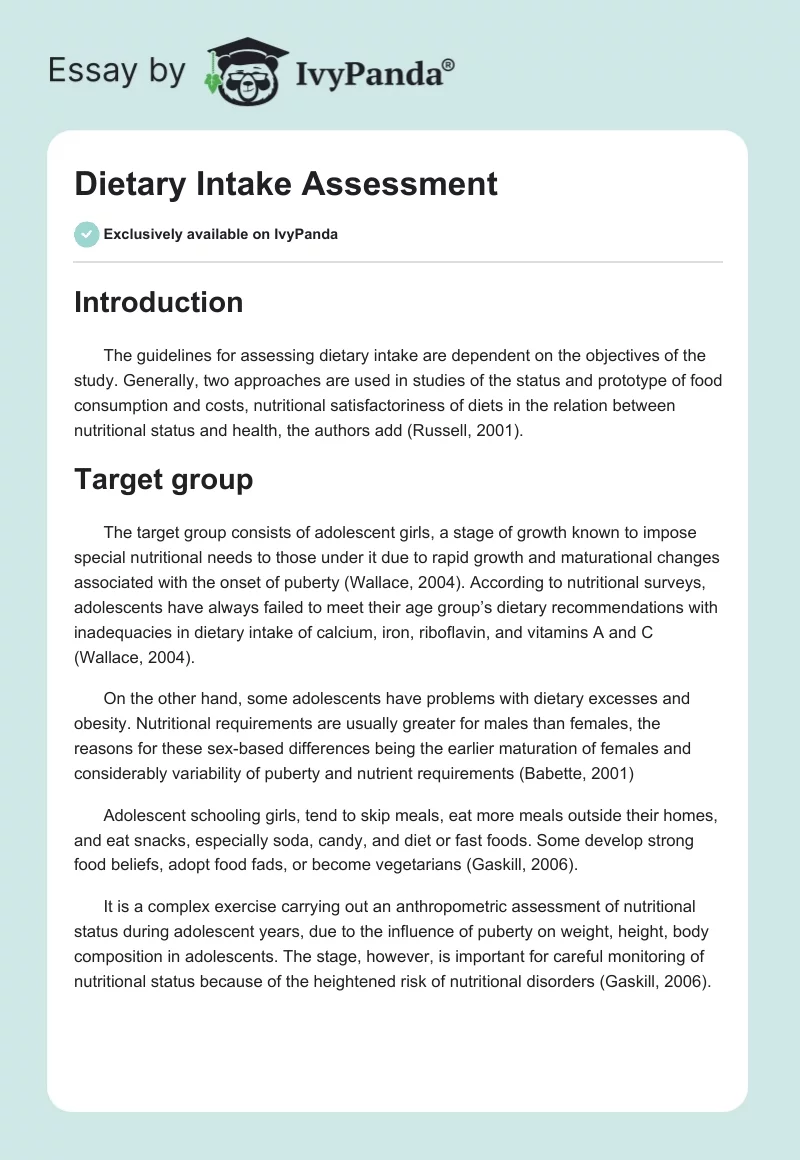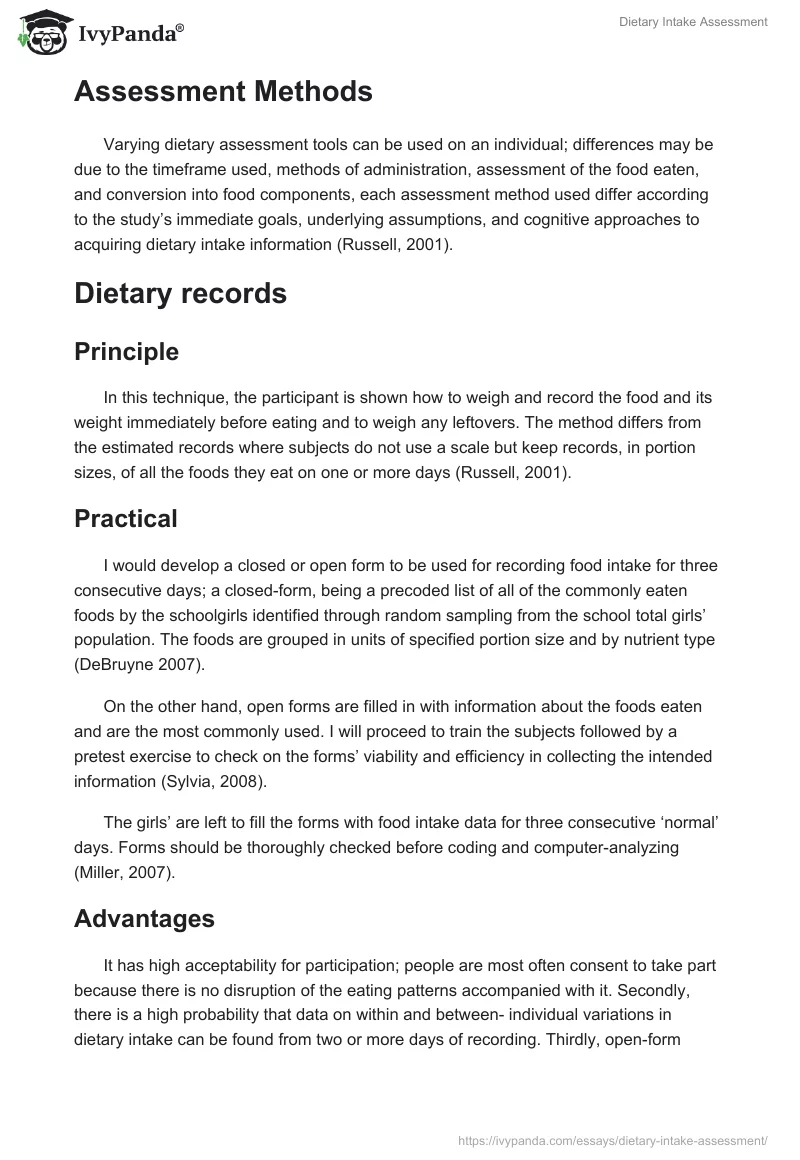Introduction
The guidelines for assessing dietary intake are dependent on the objectives of the study. Generally, two approaches are used in studies of the status and prototype of food consumption and costs, nutritional satisfactoriness of diets in the relation between nutritional status and health, the authors add (Russell, 2001).
Target group
The target group consists of adolescent girls, a stage of growth known to impose special nutritional needs to those under it due to rapid growth and maturational changes associated with the onset of puberty (Wallace, 2004). According to nutritional surveys, adolescents have always failed to meet their age group’s dietary recommendations with inadequacies in dietary intake of calcium, iron, riboflavin, and vitamins A and C (Wallace, 2004).
On the other hand, some adolescents have problems with dietary excesses and obesity. Nutritional requirements are usually greater for males than females, the reasons for these sex-based differences being the earlier maturation of females and considerably variability of puberty and nutrient requirements (Babette, 2001)
Adolescent schooling girls, tend to skip meals, eat more meals outside their homes, and eat snacks, especially soda, candy, and diet or fast foods. Some develop strong food beliefs, adopt food fads, or become vegetarians (Gaskill, 2006).
It is a complex exercise carrying out an anthropometric assessment of nutritional status during adolescent years, due to the influence of puberty on weight, height, body composition in adolescents. The stage, however, is important for careful monitoring of nutritional status because of the heightened risk of nutritional disorders (Gaskill, 2006).
Assessment Methods
Varying dietary assessment tools can be used on an individual; differences may be due to the timeframe used, methods of administration, assessment of the food eaten, and conversion into food components, each assessment method used differ according to the study’s immediate goals, underlying assumptions, and cognitive approaches to acquiring dietary intake information (Russell, 2001).
Dietary records
Principle
In this technique, the participant is shown how to weigh and record the food and its weight immediately before eating and to weigh any leftovers. The method differs from the estimated records where subjects do not use a scale but keep records, in portion sizes, of all the foods they eat on one or more days (Russell, 2001).
Practical
I would develop a closed or open form to be used for recording food intake for three consecutive days; a closed-form, being a precoded list of all of the commonly eaten foods by the schoolgirls identified through random sampling from the school total girls’ population. The foods are grouped in units of specified portion size and by nutrient type (DeBruyne 2007).
On the other hand, open forms are filled in with information about the foods eaten and are the most commonly used. I will proceed to train the subjects followed by a pretest exercise to check on the forms’ viability and efficiency in collecting the intended information (Sylvia, 2008).
The girls’ are left to fill the forms with food intake data for three consecutive ‘normal’ days. Forms should be thoroughly checked before coding and computer-analyzing (Miller, 2007).
Advantages
It has high acceptability for participation; people are most often consent to take part because there is no disruption of the eating patterns accompanied with it. Secondly, there is a high probability that data on within and between- individual variations in dietary intake can be found from two or more days of recording. Thirdly, open-form records may provide data about foods less frequently eaten. Lastly, the period is defined and portions can be weighed to increase accuracy (Miller, 2007).
Disadvantage
The first weakness is that respondents must be literate and highly cooperative. Secondly, the quantification precision misses out, necessitating the use of measures to negate the effect. Thirdly, the foods consumed from home can be recorded with less accuracy. Lastly, the recording is an additional workload on the respondents (Barker 2002)
Twenty-Four-Hour Recall
Principle
In this method, an individual has to recall actual food intake for the immediate past 24 or 48 hours, which an interviewer has to record during the one-on-one interview or by telephone. This may make use of open forms or precoded questionnaires, tape recorders, or computer programs (Costin 1999).
Practical
For this case, I will use personal interviews with the girls using open forms, for a considerable number of days. In addition to forms, a checklist shall be used at the end of the interview to capture foods that are easily forgotten like fruits or snacks. The subjects will first be taken through a short yet thorough training to enhance their capacity in responding to probing questions (Creed 2000). The recalled day will be the previous day from the time of waking up to the time of waking up on the interview day. However, no interviewed subjects should have gotten any prior notification about the day and time of the interview (Debra 1996).
Advantages
The method is quick, relatively cheap, and standardized. Response rates are rather high for recalls; not much literacy is required combined with the probing for answers.
Disadvantage
The main weakness is that a single recall does not provide information on ‘usual’ intake because of the short period. Others include the dependence on short- memory to provide information; the portion size is difficult to recall accurately (Dormody 1992).
Dietary history
Principle
The method assesses an individual’s total daily food intake and usual meal pattern over varied periods, usually any period from 1 month to six months, the technique can be in three parts. The first is an interview about the subject’s usual daily pattern of intake, the second is crosschecking using a detailed list of foods to verify the overall eating pattern, and finally, the subject to record food intake at home (Russell, 2001).
Practical
The girls will be questioned to provide information about their typical days’ eating patterns making use of precoded interviews (Sylvia, 2008).
Advantages
The major strength is that it is fabricated in away to obtain a measure of usual intake, essential in looking at the impact of diet on nutritional standing. More so, respondents’ literacy is not required for an interviewer-administered dietary history( Todd 1983).
Disadvantages
The weakness of this method mainly is that of time consumption; where the respondents are asked to make judgments about the usual meal patterns and details of food intake (Epidemiol 1982).
Food frequency method
Principle
Used to get the estimate of how frequently some foods are eaten during a specific period. It indicates the usual food group intake of an individual.
Practical
After coming up with a food frequency questionnaire containing details of foods listed, length of the reference period, response intervals for specifying the frequency of use, the procedure for estimating portion size, and manner of method administration. Training will be conducted to equip the student interviewees with an understanding of the requirements in the interviews (Boyd 2009).
Advantages
Either the method may be interviewer-administered or self-administered which takes little time to fill; can be easily automated and is not very costly(Nelson 2003).
Disadvantages
It is mainly limited in the sense that the information is at best semi-quantitative, even if portion size information is included. The other weakness of FFQ is that memory of food use in the past is required and the number, the complexity of food listed, and quantification procedures govern that respondent (Kettles 2006).
Conclusion
As described above purpose for which the data are being collected forms the basis for determining the assessment method to be used (Leutwyler 1999). The purpose for which could be either to describe: the average nutrient intake of a group, the proportion of a population at ‘risk’, average usual intake individuals for ranking in a group and usual intake in individual for nutrition management (Marr 1971). Each method has specific strengths and weaknesses, and a combination might balance the shortcomings of one with the strengths of another. Combined methods, however, are more time-consuming for respondents and field- workers (Miller, 2007).
References
Andrew P, T. Jürimäe, Body Composition Assessment in Children and Adolescents, Volume 44 of Medicine and sport science
Babette, S 2001, The present knowledge in nutrition, Adolescence, 8th edition. Washington, DC: International life sciences institute
Barker, D 2002) Behavior Body Composition and Diet in Adolescent Girls, University of Southampton, Southampton General Hospital
Boyd, N 2009, A review of the methods used by studies of Dietary measurement, Journal of Clinical Epidemiology, Volume 42, Issue 3, Pages 269-279
Costin, S 1999, A Comprehensive Guide to the Causes, Treatments and Prevention of Eating Disorders, 2nd Edition, Massachusetts: Lowell House
Creed, K 2000, Improving Dietary Intake to Prevent Anemia in Adolescent Girls Through Community Kitchens in a Periurban Population of Lima, Peru, The American Society for Nutritional Sciences
Debra, A 1996, Nutrition in women’s health, Jones & Bartlett Learning
DeBruyne, L 2007, Nutrition and diet therapy: principles and practice, 7th Edition, Cengage Learning Publisher.
Dormody, J S 1992, Nutritional assessment of latchkey school-age childcare programs in New Mexico, Child care services, New Mexico State University, Length172 pages
Epidemiol, AJ 1982, A review of validations of dietary assessment methods Block, Oxford University Press
Gaskill, S 2006, Fitness & Health, Human Kinetics, 6th edition, Human Kinetics Publishers
Kettles, M 2006, Women’s health and fitness guide, Human Kinetics, Champaign, Ill. pp 249
Leutwyler, K 1998, Dying to be thin, Scientific American, USA Inc
Wallace, JMW 2004, Issues in dietary intake assessment of children and adolescents, Britain, Cambridge University Press. vol. 92, pp S213-S222. Web.
Marr, J W 1971, Individual Dietary Surveys, Purposes and methods, USA: Nutr Diet
Miller, D 2007, Handbook of dairy foods and nutrition USA, National Dairy Council, Taylor & Francis Group, LLC, Pp427
Nelson, M 2003, Use of food photography for estimating portion size and the nutrient content of meals, Food Photography, Br J Nutr, vol. 76:31-49
Russell, R 2001, Present Knowledge in Nutrition, 8th Edition. Washington, DC: International life sciences institute press
Sylvia, E 2008, Nutrition and diagnosis-related care, Philadelphia, 6th edition, a wolters Kluwer Business
Todd K 1983, Food intake measurement: problems and approaches, 1983 by The American Society for Nutrition


